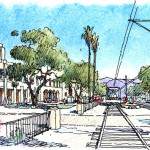Library of Codes
FBCI gathers the best examples of form-based codes from communities across the United States and abroad. The codes represent a variety of community types and applications of form-based standards. Click on the Show Search Options button to search the library by phrase, location, Driehaus Award recipients, and the categories described below.
- Physical Context: size or type of government entity
- Organizing Principle: underlying organization for the code standards
- Implementation Method: how the code standards operate within the zoning ordinance
- Development Type: development types impacted by the code standards
- Special Features: unique code attributes or awards
Azusa Development Code

The code is mandatory and separates the City into 17 planning areas of distinct character. Within planning areas, there are three types of regulatory areas, Neighborhoods, Districts and Corridors that correspond to distinctive…more
Code Documents
The Beaufort Code
This code provides a high-quality model for a small, historic, design-driven city. It demonstrates an exemplary bifurcation between form-based districts and conventional zones and is well organized and user friendly. City staff took…more
Canton Village Districts Code
 **Driehaus Honorable Mention**
**Driehaus Honorable Mention**
This code was adopted in 2018 for a suburban corridor linking established historic village centers in western Connecticut. Prior commercial strip zoning on State Route 44 is now pre-approved for higher density, mixed-use development…more
Objective Design and Development Standards
 **Driehaus Award Recipient**
**Driehaus Award Recipient**
This model code for Marin County, CA exemplifies the differentiating strengths of form-based codes: clear guidance for better design outcomes and predictable, fair, and timely review processes. While conventional codes coupled with onerous…more
Code Documents
Hartford Zoning Code
 **Driehaus Award Recipient**
**Driehaus Award Recipient**
This code serves as a comprehensive and concise model for citywide form-based standards. The approach to building types creates a rich variety of urbanism and appropriately addresses both the private and public realm.…more




